Psycho: The Complete Collection (Blu-ray) |
|
Psycho: The Complete Collection (Blu-ray) |
|
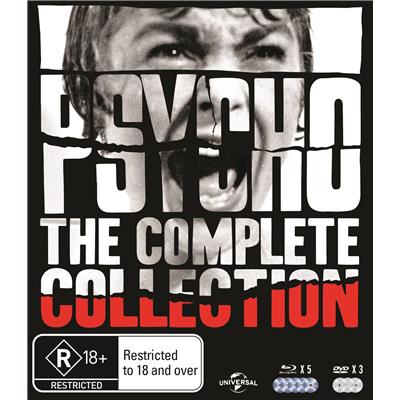

|
| BUY IT |
| Video | |
| Audio | |
| Extras | |
| Plot | |
| Overall |
Psycho (Blu-ray) (1960) |
|
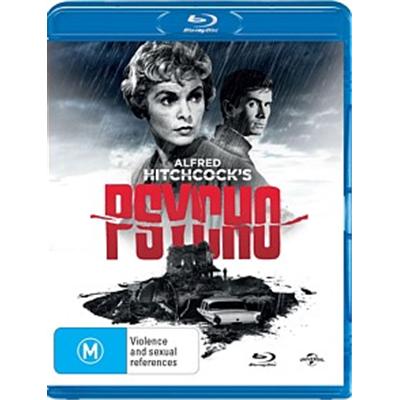

|
| BUY IT |
| General | Extras | ||
| Category | Thriller |
Featurette-Making Of-The Making of Psycho Featurette-In the Master's Shadow: Hitchcock's Legacy Audio Bites-Hitchcock/Truffaut Featurette-Newsreel Footage: The Release of Psycho Additional Footage-The Shower Scene: With & Without Music Storyboards-Shower Scene Featurette-Psycho Sound Gallery Theatrical Trailer Additional Footage-Alfred Hitchcock Presents 'Lambs to the Slaughter' |
|
| Rating |

|
||
| Year Of Production | 1960 | ||
| Running Time | 108:51 | ||
| RSDL / Flipper | Dual Layered | Cast & Crew | |
| Start Up | Language Select Then Menu | ||
| Region Coding | 1,2,3,4,5,6 | Directed By | Alfred Hitchcock |
|
Studio
Distributor |
 ViaVision |
Starring |
Anthony Perkins Janet Leigh Vera Miles John Gavin Martin Balsam John McIntire |
| Case | Standard Blu-ray | ||
| RPI | $15.95 | Music | Bernard Herrmann |
| Video | Audio | ||
| Pan & Scan/Full Frame | None |
English DTS HD Master Audio 5.1 English DTS HD Master Audio 2.0 French Dolby Digital 2.0 Italian Dolby Digital 2.0 German Dolby Digital 2.0 Spanish Dolby Digital 2.0 English Audio Commentary Dolby Digital 2.0 Japanese Dolby Digital 2.0 |
|
| Widescreen Aspect Ratio | 1.85:1 | ||
| 16x9 Enhancement |
 |
||
| Video Format | 1080p | ||
| Original Aspect Ratio | 1.85:1 | Miscellaneous | |
| Jacket Pictures | No | ||
| Subtitles |
English Japanese French Italian German Spanish Dutch Danish Finnish Portuguese Chinese Korean Swedish Norwegian |
Smoking | No |
| Annoying Product Placement | No | ||
| Action In or After Credits | No | ||
††† Itís impossible to discuss the narrative and storytelling brilliance of Alfred Hitchcockís Psycho without divulging spoilers. The movieís twists and secrets are almost common knowledge over five decades after its release, but fair warning all the same. If you have not seen Psycho and are oblivious to its surprises, stop reading this review right now and watch the movie. It is a masterpiece, and thatís all you need to know.
††† Released in 1960, Psycho has become synonymous with the late great Alfred Hitchcock, standing proudly alongside the likes of Rear Window, North By Northwest and Vertigo. An adaptation of Robert Blochís 1959 novel of the same name, Psycho was actually an attempt by Hitchcock to reinvent himself at the time and try something different. A trend had broken out in Hollywood during the 1950s, with low-risk, low-budget horrors crowding theatres and effortlessly generating a large profit. However, said movies were not often particularly good, and Hitchcock was eager to see what would happen if somebody talented helmed a comparable production. Despite being able to command lavish budgets, Hitchcock wanted to create a horror movie on the cheap with the crew of his television show Alfred Hitchcock Presents, and was even compelled to go outside the studio system to fund the movie himself. Itís a gamble that paid off, and the film still holds up today. Indeed, Psycho is not just groundbreaking, influential and oft-imitated - itís also a highly engaging, albeit disturbing horror movie.
††† A clerk in a real estate office earning an average wage, Marion Crane (Janet Leigh) is engaged in a romantic relationship with Sam Loomis (John Gavin), but they cannot get married because of Samís debts. When Marionís boss closes a lucrative real estate deal, Marion is entrusted to deposit $40,000 in cash into the bank, but the large sum of money is simply too tempting. Seeing a way out of her situation, she impulsively decides to keep it and sets off to visit Sam, but a powerful storm one night compels Marion to seek accommodation. Happening across the eerily quiet Bates Motel, which has ď12 cabins, 12 vacancies,Ē Marion meets owner Norman Bates (Anthony Perkins), a shy but well-meaning young man whoís excited by the prospect of a female visitor. However, Normanís jealous mother, who lives in a creepy old house overlooking the establishment, does not take kindly to Normanís attraction to Marion...
††† Many factors can be attributed to the success of Psycho, but the creative marketing campaign most certainly helped. Indeed, Hitchcockís name alone was enough to sell plenty of tickets, but the maestro took it one step further. Cinema staff were not permitted to let patrons enter a screening after the movie had started, and advertisements encouraged audiences not to spoil any of the twists, on top of the fact that Hitchcock purchased every copy of Blochís novel he could find to limit the bookís availability and thus keep the storyís secrets under wraps. The virtuoso filmmaker truly wanted audiences to see the film with fresh, unaware eyes, which gave Psycho the power to shock, terrify and amaze in a way thatís nearly impossible to accomplish in this age of internet gossip and spoilers. Even though the movie was almost unanimously panned by critics at the time of its initial release, hundreds of people queued up outside cinemas for hours, and Hitchcockís masterpiece fast became a nationwide phenomenon, grossing an estimated $32 million in America alone against its meagre $800,000 production budget. (Adjusted for inflation, Psychoís gross is equal to approximately $350 million in 2015.)
††† Despite being one of the motion pictures most associated with Hitchcock, Psycho is something of an anomaly for the filmmaker, as itís removed from the low-key mysteries, elegant romances and grand-scale espionage thrillers that constitute the majority of his filmography. And that was, of course, Hitchcockís intention. Whatís particularly ingenious about Psycho is its narrative edifice, with Hitchcock and screenwriter Joseph Stefano creating a horror that defies expectations with utter glee. The shocking final revelation has lost none of its power, but itís also the repercussions of the iconic shower scene that stunned audiences back in 1960. Hitchcock deliberately lulls you into thinking that an entirely different story will unfold, only to pull the rug out from underneath you with the early exit of Marion Crane and the sudden shift in narrative focus. Itís all pulled off so eloquently by Hitchcock, who favours twists over out-and-out violence.
††† Despite the advancing popularity of colour film, Hitchcock deliberately chose to lens Psycho in black and white, feeling that the movie would simply be too gory in colour. The monochrome photography is a masterstroke, enhancing the movieís shocking impact and sense of horror. But itís the sense of atmosphere which really makes Psycho unforgettable, with John L. Russellís eye-catching cinematography making superlative use of shadows, creating unease during scenes set at the ominous Bates Motel. Furthermore, Hitchcock was something of a cinematic magician, with violence being implied rather than simply shown, using trick shots and montage. Especially during the shower scene, you believe youíve witnessed more than whatís actually on the screen - the knife is never actually seen penetrating skin, with creative angles, expert editing and realistic sound design prompting our minds to fill in the blanks. Itís simply superb craftsmanship, turning the scene into a cinematic masterclass that continues to be studied. But Psycho would not be as memorable as it is without Bernard Herrmannís riveting original music. The screaming strings still send a chill down the spine, with the filmís intensity and horror confidently amplified by the accompanying soundtrack.
††† Say what you will about Psychoís content in this day and age, but audiences back in 1960 were not prepared for such a disturbing motion picture. Even in 2015, the movie has bite, which is all the more impressive considering the restrictions of the period. Psycho was released before films were actually rated; in 1960, motion pictures simply had to be approved for release. Hitchcock was therefore treading on eggshells, pushing the censorship envelope to see exactly how much he could get away with as he dabbled in cinematic taboos. On top of the obvious violence, Psycho also features a toilet being flushed, denoting the first time in cinematic history that a toilet was visible in a motion picture. Furthermore, the film shows unmarried people engaging in a sexual affair, as well as voyeurism, schizophrenia and transvestism, not to mention Marion is a thief, and Janet Leigh is glimpsed in her underwear on more than one occasion. Psycho really was a breakthrough at the time.
††† Leigh earned an Oscar nomination for her portrayal of Marion Crane, which was well deserved, but Perkins was inexplicably overlooked by the Academy. Bates is one of the greatest all-time horror icons, and Perkinsí portrayal is note-perfect. In Blochís novel, Bates was a bald, middle-aged fat man, but Stefano felt that such a character would be hard to sympathise with, choosing to write the role for a younger performer. Perkins nails it, exhibiting plenty of boyish charm and coming across as hugely sympathetic. You feel sorry for Norman, whoís the furthest thing from a vindictive horror villain imaginable, and itís impossible to imagine anybody else embodying the role as skilfully as the late Perkins. The remainder of the actors hit their marks respectably, with the likes of John Gavin, Vera Miles and Martin Balsam making a good impression in their respective roles, but Psycho is Perkinsí show.
††† It took a lot of effort in post-production to truly bring Psycho to life, with Hitchcockís beloved wife Alma (a former editor) reportedly assisting in the cutting process. Even though some have complained about an extensive psychiatric explanation in the final scene, I personally have no issue with it, especially with the haunting note that the movie closes on. Slasher flicks released since Psycho may be gorier and more graphic, but Hitchcockís film remains untouchable precisely because of what the master director was able to accomplish in a stricter era of film censorship. In 2015, the movie succeeds thanks to its fine performances, nuanced characters, brilliant narrative and superlative technical presentation. It is a must-see.
| Sharpness | |
| Shadow Detail | |
| Colour | |
| Grain/Pixelization | |
| Film-To-Video Artefacts | |
| Film Artefacts | |
| Overall |
| Dialogue | |
| Audio Sync | |
| Clicks/Pops/Dropouts | |
| Surround Channel Use | |
| Subwoofer | |
| Overall |
NOTE: To view non-R4 releases, your equipment needs to be multi-zone compatible and usually also NTSC compatible.
† † Universal's release in America lacks the Alfred Hitchcock Presents episode. A win for local.
| Video | |
| Audio | |
| Extras | |
| Plot | |
| Overall |
| Review Equipment | |
| DVD | PlayStation 4, using HDMI output |
| Display | LG 42LW6500. This display device has not been calibrated. This display device is 16x9 capable. This display device has a maximum native resolution of 1080p. |
| Audio Decoder | Built in to amplifier/receiver. This audio decoder/receiver has not been calibrated. |
| Amplification | LG BH7520TW |
| Speakers | LG Tall Boy speakers, 5.1 set-up, 180W |
Psycho II (Blu-ray) (1983) |
|
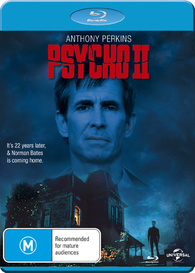
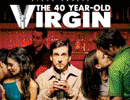
|
| BUY IT |
| General | Extras | ||
| Category | Thriller |
Interviews-Cast & Crew Trailer TV Spots Gallery-Photo Audio Interview-Cast Audio Commentary-with Tom Holland |
|
| Rating |

|
||
| Year Of Production | 1983 | ||
| Running Time | 112:45 | ||
| RSDL / Flipper | Dual Layered | Cast & Crew | |
| Start Up | Menu | ||
| Region Coding | 1,2,3,4,5,6 | Directed By | Richard Franklin |
|
Studio
Distributor |
 ViaVision |
Starring |
Anthony Perkins Meg Tilly Vera Miles Robert Loggia Dennis Franz Claudia Bryar Hugh Gillin |
| Case | Standard Blu-ray | ||
| RPI | $19.95 | Music | Jerry Goldsmith |
| Video | Audio | ||
| Pan & Scan/Full Frame | None |
English DTS HD Master Audio 5.1 English DTS HD Master Audio 2.0 English Audio Commentary DTS HD Master Audio 2.0 |
|
| Widescreen Aspect Ratio | 1.85:1 | ||
| 16x9 Enhancement |
 |
||
| Video Format | 1080p | ||
| Original Aspect Ratio | 1.85:1 | Miscellaneous | |
| Jacket Pictures | No | ||
| Subtitles | English | Smoking | No |
| Annoying Product Placement | No | ||
| Action In or After Credits | No | ||
††† Itís one thing to create a sequel to an unremarkable blockbuster like The Fast and the Furious, but itís something else entirely to attempt a follow-up to one of the most legendary, acclaimed movies of all time. For all intents and purposes, Alfred Hitchcockís Psycho didnít need a sequel; itís in the same league as films like Lawrence of Arabia, hence a follow-up sounds like madness, especially one released 23 years after the 1960 original. Robert Bloch, who wrote the Psycho novel on which Hitchcockís film is based, actually penned his own sequel novel in 1982, prompting Universal to pursue their own follow-up. Psycho II was apparently planned to be a television movie with Christopher Walken as Norman Bates, but Anthony Perkins eventually came aboard to reprise his iconic role, and the production became so overwhelmed with press coverage and interest that the studio execs pursued a theatrical release. The bad news is that Psycho II is nowhere near as good as its lightning-in-a-bottle predecessor. The good news? It was made by a crew who cared about the project and wanted to honour Hitch, and the result is a lot better than expected.
††† Opening 22 years after the end of the first film, Norman Bates (Perkins) is declared to be cured of his insanity, and of sound body and mind. He is released back into society, despite the passionate pleas of Lila Loomis (Vera Miles), the sister of one of Normanís victims, whoís convinced that the rehabilitated madman is going to kill again. Returning to his family home next to the Bates Motel, Norman takes up a job at a local diner, where he meets kindly young waitress Mary Samuels (Meg Tilly), who becomes homeless after a harsh break-up with her boyfriend. Feeling sorry for Mary and not wanting to be alone, Norman invites her to live with him. Norman sacks the new manager of the Bates Motel, and looks to fix up the place and return it to its former glory. But try as he might, Norman cannot shake the feeling that something is not quite right, as he begins receiving notes and phone calls from his ďmotherĒ. Making matters worse, people begin to go missing around the motel...
††† Although Psycho II ostensibly looks like a needless cash-in sequel, itís a solid motion picture in its own right, a well-made and suspenseful thriller that rises above the grim standard for most horror sequels. Much of the credit has to go to writer Tom Holland, a newcomer at the time who went on to script Fright Night. Thereís a lot of head-slapping ambiguity during the opening act, as Holland and director Richard Franklin toy with us like a devious cat messing with a hapless mouse. The question looms about what exactly is happening, and if Norman really is insane again. Eventually, Psycho II begins revealing itself layer by later, leading to a shocking climax beset with surprises. Also beneficial is that Psycho II functions as a sensitive character study, observing the relationship between Norman and Mary which advances Normanís story in a fascinating way. Even if the film is not on the same level as Hitchcockís masterpiece, itís surprising just how intelligent and clever this sequel truly is, as it plots its own fresh path and doesnít try to recreate its predecessor.
††† Director Richard Franklin is a self-described student of Hitchcock; he worshipped the manís work, and even met him on the set of Topaz. He does lack Hitchís brilliant artistry and ability to generate shocks and chills, but Franklinís efforts are nevertheless effective. Recruiting Halloweenís director of photography Dean Cundey, Psycho II is a handsome motion picture, exhibiting Hitchcockian influence in its lighting, framing, deliberate pacing and subtle clues about the true nature of whatís going on. Nothing here is as masterful as the iconic shower scene, but Franklin stages a number of note-worthy set-pieces, using eerie shadows and creepy production design to enhance the mood and atmosphere. One huge misstep, though, is using the shower scene from the original film to open the picture. It feels like a cheesy gimmick, something one would see in a TV movie. Added to this, the score is not as chilling or memorable as Bernard Herrmannís remarkable contributions to Hitchcockís film.
††† The role of Norman Bates haunted Perkins throughout his career, and his performance here is one of the chief reasons why Psycho II works as well as it does. Bates is completely unlike í80s horror icons like Jason Voorhees and Freddy Krueger; whereas we enjoy seeing those characters kill and maim, we donít want to see Norman lose his sanity and kill again. Perkins is so utterly pathetic, yet heartbreakingly sympathetic as well, and we feel that heís earned the right to live peacefully after such a hard life. Itís painful to watch this easily likeable man try to maintain his sanity, question what is real, face temptation, and even wonder if heís mentally stable. Perkins also brilliantly keeps us guessing; we wonder just what exactly is happening, and even when things slowly become clear at the end, even then you might not be sure. Alongside him, Meg Tilly (sister of Jennifer Tilly) provides great support; she brings a sense of innocence to the role of Mary, and sheís beautiful, making for an ideal counterpoint to Bates. Even though Perkins reportedly tried to get Tilly fired after she revealed herself to have no knowledge of the original film or of Perkinsí legacy, the pair share great chemistry, and their interplay is engaging. One of the movieís standout scenes is the climax involving Norman and Mary thatís both thrilling and emotionally powerful.
††† Apart from Perkins, the only other returning cast member from the 1960 film is Vera Miles as Lila Loomis (formerly Lila Crane). Alas, her inclusion is one of the aspects of Psycho II that fails to sit right. She serves a purpose at the beginning of the movie, actively petitioning against Normanís release, but she has more than a cameo. Where the script leads her is frightening and unnecessary, turning this smart character into an idiotic, overwrought, revenge-minded harpy. Miles delivers a strong performance as Lila, but the proceedings here tarnish the characterís name.
††† If Psycho II were a standalone thriller with no ties to Hitchcockís timeless masterpiece, it would be an exceptional movie, and perhaps would be more fondly remembered. But as a follow-up to one of the most ďuntouchableĒ movies of all time, it loses a few points, due to the fact that it simply is not Hitchcockís movie, and a few aspects are questionable. Still, Psycho II is much better than it had a right to be, further developing Normanís character, providing plenty of twists and chills, and staying true to the spirit of its predecessor. Not to mention, itís head over heels superior to a lot of horror sequels.
| Sharpness | |
| Shadow Detail | |
| Colour | |
| Grain/Pixelization | |
| Film-To-Video Artefacts | |
| Film Artefacts | |
| Overall |
| Dialogue | |
| Audio Sync | |
| Clicks/Pops/Dropouts | |
| Surround Channel Use | |
| Subwoofer | |
| Overall |
NOTE: To view non-R4 releases, your equipment needs to be multi-zone compatible and usually also NTSC compatible.
† † The Region A Shout! Factory edition is identical to our local release in terms of video/audio, and supplements. Buy local with confidence.
| Video | |
| Audio | |
| Extras | |
| Plot | |
| Overall |
| Review Equipment | |
| DVD | PlayStation 4, using HDMI output |
| Display | LG 42LW6500. This display device has not been calibrated. This display device is 16x9 capable. This display device has a maximum native resolution of 1080p. |
| Audio Decoder | Built in to amplifier/receiver. This audio decoder/receiver has not been calibrated. |
| Amplification | LG BH7520TW |
| Speakers | LG Tall Boy speakers, 5.1 set-up, 180W |
Psycho III (Blu-ray) (1986) |
|
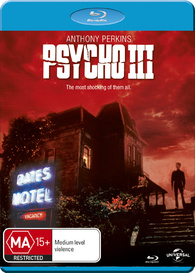

|
| BUY IT |
| General | Extras | ||
| Category | Thriller |
Featurette-Watch the Guitar - An Interview with Jeff Fahey Featurette-Patsy's Last Night - An Interview with Katt Shea Featurette-Mother's Maker - An Interview with Michael Westmore Featurette-Body Double with Brinke Stevens Theatrical Trailer Gallery-Photo Audio Commentary-with Charles Edward Pogue |
|
| Rating |

|
||
| Year Of Production | 1986 | ||
| Running Time | 92:50 | ||
| RSDL / Flipper | Dual Layered | Cast & Crew | |
| Start Up | Menu | ||
| Region Coding | 1,2,3,4,5,6 | Directed By | Anthony Perkins |
|
Studio
Distributor |
 ViaVision |
Starring |
Anthony Perkins Diana Scarwid Jeff Fahey Roberta Maxwell Hugh Gillin Lee Garlington |
| Case | Standard Blu-ray | ||
| RPI | ? | Music | Carter Burwell |
| Video | Audio | ||
| Pan & Scan/Full Frame | None |
English DTS HD Master Audio 5.1 English DTS HD Master Audio 2.0 English Audio Commentary DTS HD Master Audio 2.0 |
|
| Widescreen Aspect Ratio | 1.85:1 | ||
| 16x9 Enhancement |
 |
||
| Video Format | 1080p | ||
| Original Aspect Ratio | 1.85:1 | Miscellaneous | |
| Jacket Pictures | No | ||
| Subtitles | English | Smoking | No |
| Annoying Product Placement | No | ||
| Action In or After Credits | No | ||
††† The decision to create so much as one sequel to Alfred Hitchcockís Psycho was risky, but the crew behind 1983ís Psycho II made it work, resulting in a strong follow-up that also stands as a terrific thriller on its own terms. Another sequel was seriously pushing it, and itís unfortunate to report that 1986ís Psycho III is a tremendous step down in quality. Although Psycho III is built on an interesting conceptual framework and further develops the story of Norman Bates, the execution is mediocre at best, resulting in a 90-minute slasher that feels closer to a Friday the 13th instalment. Nevertheless, itís a blessing that the picture is not as idiotic or as insulting as it might have been in less deft hands, and one must admire Anthony Perkinsí courage to both star in and direct the movie despite having no filmmaking experience.
††† Taking place about a month after the events of Psycho II, Norman Bates (Perkins) is still the sole caretaker of the Bates Motel, living in his familyís ancient house which stands adjacent. Falling back into mental instability, Norman keeps the rotting corpse of his ďmotherĒ in her room upstairs, and she is prone to murdering the motel guests if they do not sit right with her. Norman seeks to hire another pair of hands to help with watching over the motel, recruiting wily wannabe musician Duane Duke (Jeff Fahey). Meanwhile, a new patron has moved into the motel; troubled former nun Maureen (Diana Scarwid), who strongly reminds Norman of one of his victims, Marion Crane. As Norman and Maureen grow closer and feel a mutual attraction to one another, Normanís mother grows unhappy with their relationship. Complicating matters further, tenacious reporter Tracy Venable (Roberta Maxwell) begins snooping around, determined to uncover proof that Norman is responsible for the recent disappearances of several people.
††† From the very outset, we know that Norman is a schizophrenic murderer again, with writer Charles Edward Pogue providing a behind-the-curtain glimpse of Norman conversing with his dead mother and preparing to kill. In theory itís interesting to see this side of Norman, but Psycho III is low on surprises. Psychoís ending was groundbreaking, while Psycho II also packed a handful of shocking twists, but Psycho IIIís conclusion is unsurprising and rote, making little impact. Itís clever to turn this instalment into more of a character study, but Pogue and Perkins do not take full advantage of the set-up. Furthermore, Psycho III was never going to live up to Hitchcockís film in any capacity, but it keeps inviting comparisons. Psycho II worked because it found its own voice while subtly paying homage to the Master of Suspense, but Psycho III takes things a step further, with murders that visually recreate the death scenes in the 1960 original. Itís too awestruck with Hitchcockís film, and as a result itís not bold enough to try anything innovative. In fact, itís so awestruck with Hitch in general, as Perkins even stages a homage to Vertigo to open the picture. Psycho III is at its best when it introduces its own creative, twisted moments, including a marvellous scene in which the sheriff eats from the motelís tainted ice machine. In another perfect moment, Norman as Mother is on a rampage, but decides to straighten up a painting while pursuing his victim.
††† The true horror of Hitchcockís Psycho was its ďless is moreĒ approach, necessitated because Hitch had strict censorship guidelines to adhere to, else his movie would not be released. The Master of Suspense took the limitations in his stride, resulting in a very classy horror movie. A knife is never shown piercing the skin, with the death scenes creatively shot to compel us to mentally fill in the blanks. Psycho III, on the other hand, was created in a different time period, when gratuitous í80s slashers were rampant, hence on-screen nudity and explicit violence was not only allowed but encouraged. Perkins (bless his heart) gives it his all, but his directorial approach is too obvious and unremarkable, and consequently Psycho III lacks scares and chilling moments. Itís all a bit rote, and one must wonder what a Hitchcock-inspired virtuoso like Brian De Palma couldíve made of this project. That said, there is one aspect of Psycho III that really works: Carter Burwellís terrific synch score. Itís a far cry from Bernard Herrmannís music, but Burwellís work is nicely atmospheric.
††† Even if the film is marred by several issues, Perkinsí performance as Norman Bates is as brilliant as always has been. Norman represents an ideal antithesis to slasher movie icons; although he does commit unspeakably brutal acts of murder, heís morally conflicted about it, coming across as a man-child unable to control his mental state. You feel genuine sympathy for Norman, and though you know that he needs to be locked up again, you do not want him to be caught or arrested. Also good here is Scarwid as Maureen, while Fahey is wonderfully sleazy as Duke.
††† Psycho III is not essential viewing, and, like Psycho II, itís unable to recapture the artistry and ingeniousness of Hitchcockís original film. Psycho really did not need any sequels, and it doesnít help that this is pretty much a run-of-the-mill í80s slasher. Still, itís a worthwhile enough continuation of Psycho II, and those interested in the Bates mythos should find it to be a fun watch.
| Sharpness | |
| Shadow Detail | |
| Colour | |
| Grain/Pixelization | |
| Film-To-Video Artefacts | |
| Film Artefacts | |
| Overall |
| Dialogue | |
| Audio Sync | |
| Clicks/Pops/Dropouts | |
| Surround Channel Use | |
| Subwoofer | |
| Overall |
NOTE: To view non-R4 releases, your equipment needs to be multi-zone compatible and usually also NTSC compatible.
† † Our local release is a direct port of the Shout! Factory disc (there are only a few disc menu differences), with the same HD presentation and the same extras. A draw.
| Video | |
| Audio | |
| Extras | |
| Plot | |
| Overall |
| Review Equipment | |
| DVD | PlayStation 4, using HDMI output |
| Display | LG 42LW6500. This display device has not been calibrated. This display device is 16x9 capable. This display device has a maximum native resolution of 1080p. |
| Audio Decoder | Built in to amplifier/receiver. This audio decoder/receiver has not been calibrated. |
| Amplification | LG BH7520TW |
| Speakers | LG Tall Boy speakers, 5.1 set-up, 180W |
Psycho IV: The Beginning (Blu-ray) (1990) |
|
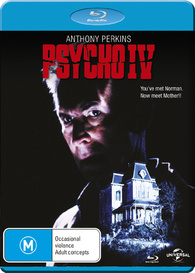

|
| BUY IT |
| General | Extras | ||
| Category | Thriller | None | |
| Rating |

|
||
| Year Of Production | 1990 | ||
| Running Time | 96:20 | ||
| RSDL / Flipper | Dual Layered | Cast & Crew | |
| Start Up | Menu | ||
| Region Coding | 1,2,3,4,5,6 | Directed By | Mick Garris |
|
Studio
Distributor |
 ViaVision |
Starring |
Anthony Perkins Henry Thomas Olivia Hussey CCH Pounder Warren Frost Donna Mitchell |
| Case | Standard Blu-ray | ||
| RPI | $15.95 | Music | Graeme Revell |
| Video | Audio | ||
| Pan & Scan/Full Frame | None | English DTS HD Master Audio 5.1 | |
| Widescreen Aspect Ratio | 1.85:1 | ||
| 16x9 Enhancement |
 |
||
| Video Format | 1080p | ||
| Original Aspect Ratio | 1.33:1 | Miscellaneous | |
| Jacket Pictures | No | ||
| Subtitles | None | Smoking | No |
| Annoying Product Placement | No | ||
| Action In or After Credits | No | ||
††† It has been stated before and it deserves to be repeated: Alfred Hitchcockís Psycho did not need to be sequelised. But that didnít stop sequels from materialising, leading to the unexpectedly strong Psycho II and the underwhelming Psycho III. Released in 1990, Psycho IV: The Beginning is the final instalment in the Psycho franchise (save for the remake and the recent TV show), and the last motion picture to feature Anthony Perkins in his most iconic role. Although the last two sequels were released theatrically, Psycho IV debuted on cable television, hence itís a fairly low-key affair, for better or for worse. The good news is that this fourth movie is better than Psycho III, and is actually a fairly decent movie in its own right, but of course it falls far short of the timeless classic that spawned it.
††† Rather than another murder spree for Norman Bates (Perkins), Psycho IV functions as a prequel of sorts, which is tradition for horror franchises. Norman now lives peacefully with his wife Connie (Donna Mitchell), who informs him that they are having a baby even though Norman is vehemently against continuing the Bates lineage. Late one night, Norman calls into a late-night radio show hosted by Fran Ambrose (CCH Pounder) whoís covering the topic of why sons kill their mothers. Calling in under the pseudonym of ĎEdí (a nod to Ed Gein, the serial killer whom Bates is based on), Norman relays the tale of his younger years when he lived with his mother Norma (Olivia Hussey). A controlling, demanding woman with severe mood swings, Norma psychologically abused Norman (played as a teenager by Henry Thomas) and repressed his sexuality, driving him to commit murder. And while telling his story on radio, Norman also explains that he has the urge to kill just once more...
††† For a television film, Psycho IV was a fairly ambitious project. After all, it follows in the footsteps of Hitchcockís immortal classic and was even penned by Joseph Stefano, who wrote the screenplay for the 1960 film (adapting Robert Blochís novel). Even though thereís a IV in the title, one doesnít need to have seen the other sequels in order to watch this one - Psycho IV plays out as more of a direct sequel to Hitchcockís movie, though II and III arenít exactly contradicted either. Whereas Norma has been heavily discussed in previous films, this is the first instalment to feature scenes of her when she was alive, providing a firsthand glimpse of Normanís upbringing. However, the relationship is not as layered and nuanced as perhaps it should, with Norma written as an outright evil character. Psycho IV also misses the chance to do something more novel with Batesí backstory, not to mention Stefano neglects the dark comedy aspect that was most notably present in the prior sequels, making this a very serious affair.
††† Despite the problematic writing, Psycho IV nevertheless does its job well enough. At the helm was Mick Garris, who also directed the likes of Critters 2 and Sleepwalkers. Working from a modest budget, the movie is fairly basic in its cinematography and direction, lacking the spark of visual elegance previously provided by Hitchcock and Richard Franklin (Psycho II). A defter cinematographer might have made the picture more exciting, yet itís still competent enough, especially for a TV movie produced in 1990. Murder scenes are often thrilling, particularly the intense scene of Norman poisoning his mother and her lover, and Garris keeps the movie chugging along at an agreeable pace for its humble 96-minute duration. The score, composed by Graeme Revell (The Crow, Sin City), often slavishly recreates Bernard Herrmannís iconic sound, yet itís mostly effective.
††† Perkins, who had directed Psycho III and was perpetually associated with Bates, is note-perfect as to be expected, effortlessly slipping back into his notorious role as if no time had passed. Itís hard not to like Perkins, with his boyish good looks and limitless charisma, which gives the film an edge. Meanwhile, Henry Thomas, who was so adorable in Steven Spielbergís E.T., is a superb young Norman Bates, managing to mimic Perkinsí traits without coming off as forced - itís easy to accept that this is the same character. Heís one of the filmís main assets, and heís sympathetic despite the awful acts he commits. And as Normanís mother, Hussey does her best with the overly one-dimensional role, believable as both a loving mother and a cruel sadist. Worth noting that Hussey actually appeared in 1974ís Black Christmas, one of the many slasher films that was inspired by Hitchcockís Psycho. The rest of the ensemble are serviceable, with Pounder making a particularly good impression as the radio host.
††† Psycho IV is frequently criticised, often unfairly so. Of course it pales in comparison to the first movie, but basically every horror movie does. What matters is that itís not an awful sequel, and it doesnít tarnish the franchise. Added to this, itís an improvement over Psycho III, and itís at least admirable that the movie doesnít turn Bates into a mindless slasher like Jason Voorhees or Michael Myers. Though not scintillating, Psycho IV is a perfectly respectable way to close the series, and a fine way to conclude the story of Norman Bates, who still retains sympathy and humanity thanks to Perkinsí fine, nuanced portrayal.
| Sharpness | |
| Shadow Detail | |
| Colour | |
| Grain/Pixelization | |
| Film-To-Video Artefacts | |
| Film Artefacts | |
| Overall |
| Dialogue | |
| Audio Sync | |
| Clicks/Pops/Dropouts | |
| Surround Channel Use | |
| Subwoofer | |
| Overall |
NOTE: To view non-R4 releases, your equipment needs to be multi-zone compatible and usually also NTSC compatible.
† † On August 23rd, 2016, Shout Factory released a Region A-locked Blu-ray edition. Reportedly it only features lossless 2.0 audio as opposed to our 5.1 track, though I cannot comment on which is better. However, Shout's Blu-ray comes with exclusive special features:
| Video | |
| Audio | |
| Extras | |
| Plot | |
| Overall |
| Review Equipment | |
| DVD | PlayStation 4, using HDMI output |
| Display | LG 42LW6500. This display device has not been calibrated. This display device is 16x9 capable. This display device has a maximum native resolution of 1080p. |
| Audio Decoder | Built in to amplifier/receiver. This audio decoder/receiver has not been calibrated. |
| Amplification | LG BH7520TW |
| Speakers | LG Tall Boy speakers, 5.1 set-up, 180W |
Psycho (1998) (Blu-ray) |
|
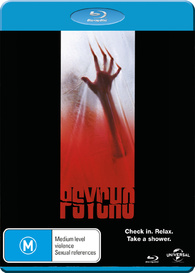

|
| BUY IT |
| General | Extras | ||
| Category | Thriller |
Featurette-Psycho Path - Documentary Additional Footage-International News Reel Footage Additional Footage-Additional Shower Scene Theatrical Trailer Gallery |
|
| Rating |

|
||
| Year Of Production | 1998 | ||
| Running Time | 105 | ||
| RSDL / Flipper | Dual Layered | Cast & Crew | |
| Start Up | Menu | ||
| Region Coding | 1,2,3,4,5,6 | Directed By | Gus Van Sant |
|
Studio
Distributor |
 ViaVision |
Starring |
Vince Vaughn Anne Heche Julianne Moore Viggo Mortensen William H. Macy Robert Forster Philip Baker Hall |
| Case | Standard Blu-ray | ||
| RPI | $19.95 | Music |
Danny Elfman Steve Bartek |
| Video | Audio | ||
| Pan & Scan/Full Frame | None | English DTS HD Master Audio 5.1 | |
| Widescreen Aspect Ratio | 1.85:1 | ||
| 16x9 Enhancement |
 |
||
| Video Format | 1080p | ||
| Original Aspect Ratio | 1.85:1 | Miscellaneous | |
| Jacket Pictures | No | ||
| Subtitles | None | Smoking | No |
| Annoying Product Placement | No | ||
| Action In or After Credits | No | ||
††† Even in 2015, simply the notion of remaking Alfred Hitchcockís Psycho seems every bit as ill-advised, pointless and idiotic as it did back in the 1990s. Why waste time and money to remake perfection? This ďwhyĒ can admittedly be addressed in a financial sense, since Universal likely assumed that there would be a built-in audience of curious fans and oblivious film-goers. However, there is no artistic motive to remake Psycho, especially with director Gus Van Sant staging a scene-for-scene, almost shot-for-shot aping of Hitchcockís original, except now itís in colour, stars a more modern cast, and is supported by a generous budget. A mostly limp, paint-by-numbers bore, 1998ís Psycho is still every bit as dreadful as ever, with the filmís shonky reputation now speaking for itself.
††† A real estate secretary earning a thankless wage who yearns to do more with her life, Marion Crane (Anne Heche) is entrusted by her employer to deposit $400,000 in the bank. (For those keeping score, it was only $40,000 in the original.) However, Marion perceives the sizeable sum of money as an opportunity for a fresh start, impulsively deciding to steal it and run. En route to visit her boyfriend Sam (Viggo Mortensen), an exhausted Marion pulls into the Bates Motel on a rainy evening, where she meets proprietor Norman Bates (Vince Vaughn). Events of this evening eventually turn violent, with the jealous rage of Normanís twisted mother putting an end to Marionís plans. Once Marionís disappearance becomes worrisome to those close to her, private investigator Milton Arbogast (William H. Macy) is recruited to hopefully put an end to the mystery.
††† Ironically, Van Sant once stated in a Newsweek article that he detests remake. In fact (irony of all ironies), he calls his Psycho an ďanti-remake film.Ē But producing something comparable to his ambitions requires a deft touch that simply eludes Van Sant, with the picture bearing no evidence of satire underneath its surface. Itís just extremely dreary and meaningless.
††† Remakes are not inherently bad, as some remakes have successfully produced a new, exciting interpretation of older material. Hell, recycling ideas and stories has been a staple of Hollywood since cinemaís inception - Akira Kurosawaís samurai masterpiece Yojimbo was remade as both A Fistful of Dollars and Last Man Standing, while John Sturgesí The Magnificent Seven was a western appropriation of Kurosawaís Seven Samurai. But Hitchcockís Psycho does not possess the type of transcendent premise that easily yields itself to a new reimagining, and apparently Van Sant himself even knew this. Thus, Van Sant actually re-uses Joseph Stefanoís screenplay for the original film, making a few minor changes along the way. Moreover, with Van Sant wanting to produce a shot-for-shot recreation, he constantly referred back to Hitchcockís film on-set, asking the performers to mimic movements to the best of their abilities.
††† Granted, if Van Sant made any major alterations, it may have alienated Hitchcock purists, but at least the project would have been bolder and more compelling. What if the entire story was told from Normanís perspective? What if Van Sant produced a page-for-page translation of Robert Blochís source novel? Instead, this Psycho is tragically gutless, with small changes that are detrimental if anything. There is some rear nudity, for instance, the setting is modernised, and Norman is unmistakably masturbating as he peeps on Marion. Thus, the movie copies Hitchcock without paying heed of his ďless is moreĒ approach. How ironic. Hereís the big problem: even if you want to praise something in 1998ís Psycho, you would be much better off praising the Hitchcock film. In fact, youíd be better off just watching the Hitchcock film as opposed to this drivel. Furthermore, one of the biggest reasons for Psychoís success in 1960 was because of how bold, original and unexpected it was, with strict cinema policies to avoid spoiling any surprises. But the twists are well-known now, lessening this remakeís impact, especially since it lacks unexpected twists of its own.
††† With Van Sant determined to include every line and pause from Hitchcockís original, nothing flows naturally; it all feels very awkward, with lines and actions included perfunctorily rather than organically. To be sure, the presentation is professional, as to be expected from the budget, while Danny Elfman recreates every cue of Bernard Herrmannís original compositions in rousing stereo. But with the film feeling so forced, this incarnation of Psycho is not particularly thrilling or scary, playing out in a slapdash fashion. Added to this, the movie feels strangely humdrum in colour, whereas Hitchcockís stylish black and white photography enhanced his filmís unnerving mood. Even the remade shower scene is an absolute dud, lacking the immediacy of the original film. Almost all shots are recreated (though pointless flashes of a stormy sky are thrown in as well), adding up to nothing except a lifeless imitation, much like the rest of the movie. Motion pictures are supposed to constantly evolve, with script revisions in pre-production and on-set, while editors continuously tinker with a movie in post-production, adding and removing shots, scenes or lines of dialogue. This is exactly why this Psycho never works, as itís too closely tethered to the original movie, stuck with moments that worked for Hitchcockís film but are simply ineffective here.
††† The performances are another issue, as the cast play surface-level impersonations of their characters instead of embodying them. Heche pales in comparison to Janet Leigh, and is unable to recite lines without sounding hopelessly forced. Mortensen is equally weak, and frequently sounds as if heís just reciting lines from nearby cue cards, though Julianne Moore and William H. Macy do fare slightly better. Most lamentably, Vaughn is unable to present a truly compelling interpretation of Norman Bates, despite his attempts to imitate a number of Anthony Perkinsí mannerisms. Itís actually quite amusing to look back at Vaughn trying his hand at a serious performance here, since he now works exclusively in comedy, and the notion of Vaughn in a straight-faced drama or thriller is sure to provoke ridicule. Vaughn fails to breath life into his portrayal of Bates, spouting the original dialogue in an often unconvincing fashion.
††† The makers of 1998ís Psycho obviously wanted to pay tribute to Hitchcockís exceptional work, but the film comes across as more of an expensive self-indulgent exercise - it was, after all, undoubtedly more fun for Van Sant and crew to make the film than it will be for an anybody to watch the fruit of their labours. All these years on, this remake is only worth watching as a historical curiosity, though there probably is an audience of young modern movie-goers who would prefer to watch this newer, colour version of Psycho over the ďoldĒ original. With its critical mauling, terrible reputation and box office failure, 1998ís Psycho has only served one useful purpose: It has discouraged other studios and filmmakers from doing another remake of Hitchís untouchable classic.
| Sharpness | |
| Shadow Detail | |
| Colour | |
| Grain/Pixelization | |
| Film-To-Video Artefacts | |
| Film Artefacts | |
| Overall |
| Dialogue | |
| Audio Sync | |
| Clicks/Pops/Dropouts | |
| Surround Channel Use | |
| Subwoofer | |
| Overall |
NOTE: To view non-R4 releases, your equipment needs to be multi-zone compatible and usually also NTSC compatible.
† † On May 9th, 2017, Shout Factory released a Region A-locked Blu-ray edition. The transfer appears to be identical. Shout's edition misses out on the "Additional Shower Scene" and "International News Reel Footage" but adds:
| Video | |
| Audio | |
| Extras | |
| Plot | |
| Overall |
| Review Equipment | |
| DVD | PlayStation 4, using HDMI output |
| Display | LG 42LW6500. This display device has not been calibrated. This display device is 16x9 capable. This display device has a maximum native resolution of 1080p. |
| Audio Decoder | Built in to amplifier/receiver. This audio decoder/receiver has not been calibrated. |
| Amplification | LG BH7520TW |
| Speakers | LG Tall Boy speakers, 5.1 set-up, 180W |
Bates Motel (1987) (NTSC) |
|
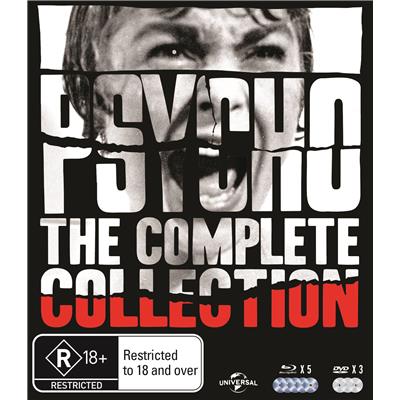

|
| BUY IT |
| General | Extras | ||
| Category | Thriller | None | |
| Rating |

|
||
| Year Of Production | 1987 | ||
| Running Time | 90 | ||
| RSDL / Flipper | No/No | Cast & Crew | |
| Start Up | Programme | ||
| Region Coding | 1,2,3,4,5,6 | Directed By | Richard Rothstein |
|
Studio
Distributor |
 ViaVision |
Starring |
Bud Cort Lori Petty Moses Gunn Gregg Henry Khrystyne Haje Jason Bateman Kerrie Keane Kurt Paul |
| Case | ? | ||
| RPI | Box | Music | J. Peter Robinson |
| Video (NTSC) | Audio | ||
| Pan & Scan/Full Frame | Full Frame | English Dolby Digital 2.0 mono | |
| Widescreen Aspect Ratio | None | ||
| 16x9 Enhancement | No | ||
| Video Format | 480i (NTSC) | ||
| Original Aspect Ratio | 1.33:1 | Miscellaneous | |
| Jacket Pictures | No | ||
| Subtitles | None | Smoking | No |
| Annoying Product Placement | No | ||
| Action In or After Credits | No | ||
††† Long before A&Eís Bates Motel premiered in 2013, there was the 1987 telemovie Bates Motel, which was designed to be a pilot for a potential television show. Suffice it to say, the show was never picked up by any network, and itís not hard to see why. Written and directed by Richard Rothstein, the movie disposes of everything that made Psycho so fascinating in the first place, and it doesnít even focus on franchise lead Norman Bates. Rather than a disturbing horror like Alfred Hitchcockís timeless classic, Bates Motel is a bewildering thriller/fantasy concoction with very little merit in its premise or execution. For Hitchcock fans, itís a frustrating insult.
††† After the events of the first movie, Norman Bates (briefly played here by Kurt Paul) is sent to a mental asylum, where he meets troubled young boy Alex West (Bud Cort) who murdered his abusive stepfather. Norman takes Alex under his wing, essentially acting as his surrogate father. Coincidentally, Norman dies in the same year that Alex is set to be released, and Normanís will specifies that Alex is to inherit the Bates Motel as well as the nearby family home. Travelling to the rundown motel, Alex meets a plucky squatter named Willie (Lori Petty), who convinces Alex to let her hang around. Wanting to honour Norman, Alex becomes determined to renovate the old Bates Motel and re-open the establishment to the public. However, Alex begins to see a dark figure lurking around the residence who looks like Mrs. Bates, and things begin to happen which threaten Alexís dream.
††† Bates Motel ill-advisedly and inexplicably retcons the Psycho sequels, playing out as a direct follow-up to Hitchcockís Psycho. However, there are fundamental flaws and inconsistencies that cannot be ignored by anybody who has actually watched Psycho, let alone those who know it intimately. For instance, in Hitchcockís movie, the motel resides about fifteen miles outside of Fairvale, but in Bates Motel, the establishment is a half-mile away from ďFairville.Ē Worse, in the movies and in Robert Blochís Psycho novel, Normanís mother is named Norma, but all the characters here seem to think that Mrs. Batesí first name is Gloria. And while the construction crews are working on the motel here, they stumble upon the body of Mrs. Bates, which makes no sense since her body would have been properly laid to rest after being found in Hitchcockís movie. Unless Norman broke out of the asylum to specifically steal his motherís body again, just to bury it at the motel... See how none of this makes any sense? One has to seriously wonder if Rothstein has even seen the Hitchcock film - in all likelihood, he just read a brief plot outline of Psycho before working on his screenplay.
††† Bizarrely, Rothstein turns Bates Motel into a saccharine supernatural sitcom, with kind-hearted ghosts and no murders. Itís a peculiar knockoff of the likes of Twilight Zone and Fantasy Island, involving guests checking in where they confront their fears and emerge as a whole new person. Out of nowhere in the final act, a woman (played by Kerrie Keane) checks into the motel looking to commit suicide, but a group of deceased teens rise from the grave to have a í50s-style party and persuade her to change her mind. Jason Bateman even stars as one of the teens, and all the ghosts pay Alex to rent rooms in the motel. Despite the fact that this subplot is utterly ridiculous, the supernatural has never been part of the Psycho mythology; itís a tale about monsters within. By leaning on this crap, Bates Motel negates the very thing that made the original movie such a unique entity.
††† The only noticeable tie-in to Psycho is the Bates Motel setting (though itís renovated beyond all recognition), and the brief appearance of Norman, who isnít even played by Anthony Perkins. Worse, the majority of the movie is concerned with the hopelessly humdrum machinations involved in getting the motel up and running again, lacking the type of Hitchcockian suspense that should be omnipresent in a production like this. Even though ostensibly spooky things do happen, such sequences are not scary or unnerving, and climactic reveals fundamentally transform the entire enterprise into an episode of Scooby Doo. On this note, the movieís tone is all over the place, with irritating attempts at comedy - Willie is even introduced wearing a f***ing chicken costume. Itís an outrage to see such content in a Psycho spinoff, and the film even ends with Alex breaking the fourth wall, because TV.
††† Things were eventually set right in the Psycho universe with the release of Psycho IV: The Beginning in 1990, which ignores Bates Motel and exists in the same continuity as the other Psycho sequels. Thus, itís easy for fans of the Psycho film series to continue happily ignoring Bates Motel, which is in the same league as the Star Wars Holiday Special - a historical curiosity thatís probably better left unseen. Hell, even Anthony Perkins himself detested the film.
| Sharpness | |
| Shadow Detail | |
| Colour | |
| Grain/Pixelization | |
| Film-To-Video Artefacts | |
| Film Artefacts | |
| Overall |
| Dialogue | |
| Audio Sync | |
| Clicks/Pops/Dropouts | |
| Surround Channel Use | |
| Subwoofer | |
| Overall |
NOTE: To view non-R4 releases, your equipment needs to be multi-zone compatible and usually also NTSC compatible.
† † All DVD releases worldwide are identical. No extras, same shoddy presentation. Draw.
| Video | |
| Audio | |
| Extras | |
| Plot | |
| Overall |
| Review Equipment | |
| DVD | PlayStation 4, using HDMI output |
| Display | LG 42LW6500. This display device has not been calibrated. This display device is 16x9 capable. This display device has a maximum native resolution of 1080p. |
| Audio Decoder | Built in to amplifier/receiver. This audio decoder/receiver has not been calibrated. |
| Amplification | LG BH7520TW |
| Speakers | LG Tall Boy speakers, 5.1 set-up, 180W |
The Psycho Legacy (2010) (NTSC) |
|
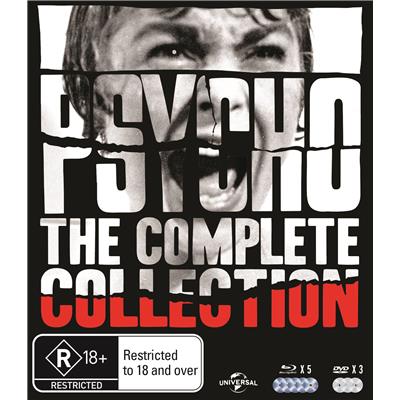

|
| BUY IT |
| General | Extras | ||
| Category | Documentary |
Deleted Scenes Additional Footage-Extended Interviews Interviews-Cast-Full panel discussion with Perkins Featurette-PSYCHO reunion panel Featurette-A tour of the Bates Motel Featurette-Revisiting PSYCHO II Featurette-Shooting PSYCHO II Featurette-A visit with PSYCHO memorabilia collector Guy Thorpe Featurette-PSYCHO on the Web Gallery |
|
| Rating | ? | ||
| Year Of Production | 2010 | ||
| Running Time | 96:59 | ||
| RSDL / Flipper |
Dual Layered Dual Disc Set |
Cast & Crew | |
| Start Up | Menu | ||
| Region Coding | 1,2,3,4,5,6 | Directed By | Robert V. Galluzzo |
|
Studio
Distributor |
ViaVision | Starring | None Given |
| Case | ? | ||
| RPI | Box | Music | Jermaine Stegall |
| Video (NTSC) | Audio | ||
| Pan & Scan/Full Frame | Full Frame | English Dolby Digital 2.0 mono | |
| Widescreen Aspect Ratio | None | ||
| 16x9 Enhancement | No | ||
| Video Format | 480i (NTSC) | ||
| Original Aspect Ratio | 1.78:1 | Miscellaneous | |
| Jacket Pictures | No | ||
| Subtitles | None | Smoking | No |
| Annoying Product Placement | No | ||
| Action In or After Credits | No | ||
††† The production of Alfred Hitchcockís Psycho has been exhaustively documented, with the film having been given a lot of attention for its two-disc special edition DVD release. But each DVD release of the three Psycho sequels has been barebones, with no commentaries or featurettes to shed light on the productions. Thus, Psycho super-fan Robert Galluzzo became determined to fix this oversight, spearheading a documentary that ultimately became The Psycho Legacy. Universal were uninterested in the project, however, leaving Galluzzo to personally finance the project himself, though he was permitted to use stills and footage of all four Psycho movies. Itís not a perfect documentary, nor is it definitive in any way, but one does have to admire Galluzzoís tenaciousness, securing interviews with a variety of participants to piece together a fascinating documentation of the making of all four films.
††† The Psycho Legacy is broken down into four main segments, with each of the four Psycho films being explored in varying degrees of detail. Since the making of Hitchcockís film has been the subject of a number of documentaries, Galluzzo does not spend a great deal of time on the original Psycho, instead devoting the majority of the feature to uncharted territory. Reportedly, segments were created for 1987ís Bates Motel and the 1998 Psycho remake, but they were excised from the final edit and have disappeared entirely, not even featuring as DVD extras. Even though both productions are terrible by all accounts, it would still be fascinating to get some behind-the-scenes details of both projects, and some retrospective thoughts on them.
††† Galluzzo interviews a wide variety of participants, including many of Anthony Perkinsí co-stars, Psycho IV director Mick Garris, and a few Psycho enthusiasts. He also reaches into the vaults, digging up ancient video pieces with Richard Franklin and Anthony Perkins. Heartbreakingly, Franklin was slated to be interviewed in the early stages of the production (the project was announced in 2007), but the Australian filmmaker died before Galluzzo had the chance to get him in front of a camera. That is forgivable given the circumstances, but it is an issue that substantial airtime is given to a number of interviewees with no direct involvement in the films, and several key cast members are MIA. Indeed, itís a travesty that the likes of Meg Tilly and Roberta Maxwell are not on hand, as they would no doubt have provided more valuable insight. Psycho II cinematographer Dean Cundey does not even feature here, with all of his interview being relegated to a separate DVD extra.
††† The Psycho Legacy was released hot on the heels of the mind-bogglingly extensive, four-hour documentary about the Nightmare on Elm Street franchise, Never Sleep Again. By comparison, this 90-minute Psycho documentary is a bit of a letdown, and it is hampered to an extent by its unmistakably amateurish construction. There is simply not enough visual flair, with the movie wearing its fan-made origins on its sleeve. Furthermore, as stated previously, Galluzzo does use interviews with fans a bit too often. While they occasionally impart interesting trivia, for the most part itís stuff you can read on Wikipedia on IMDb, and they often discuss their admiration for scenes, characters, or pieces of music. As a result, The Psycho Legacy does often feel like a fan video rather than a definitive behind-the-scenes look.
††† Taken as a standalone motion picture, The Psycho Legacy comes up short, though it does have some interesting production anecdotes to impart. For viewers who have seen all four Psycho films, and enjoy at least one or two of them, this documentary is worth seeing for the discussion of the often overlooked sequels.
| Sharpness | |
| Shadow Detail | |
| Colour | |
| Grain/Pixelization | |
| Film-To-Video Artefacts | |
| Film Artefacts | |
| Overall |
| Dialogue | |
| Audio Sync | |
| Clicks/Pops/Dropouts | |
| Surround Channel Use | |
| Subwoofer | |
| Overall |
NOTE: To view non-R4 releases, your equipment needs to be multi-zone compatible and usually also NTSC compatible.
† † The Psycho Legacy has been released on DVD in the United States by Shout! Factory, and our set is a direct port, with all the same extras. However, the documentary has seen a Blu-ray release over in Germany, flaunting a 1080i video presentation and DTS-HD 5.1 audio tracks in both German and English. Reviews are hard to come by, but reportedly the video is a SD upscale, so itís probably not worth the import. Draw.
| Video | |
| Audio | |
| Extras | |
| Plot | |
| Overall |
| Review Equipment | |
| DVD | PlayStation 4, using HDMI output |
| Display | LG 42LW6500. This display device has not been calibrated. This display device is 16x9 capable. This display device has a maximum native resolution of 1080p. |
| Audio Decoder | Built in to amplifier/receiver. This audio decoder/receiver has not been calibrated. |
| Amplification | LG BH7520TW |
| Speakers | LG Tall Boy speakers, 5.1 set-up, 180W |